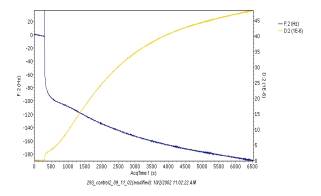The quartz crystal microbalance with dissipation (QCM-D) technique has been found to be a versatile technique for quickly distinguishing initial cell-surface interactions on different biomaterials. However, the exact relationship between frequency change and biological processes, such as adhesion, still needs to be defined.

Fig.1: Frequency and dissipation graph from the QCM.
In this study, a (QCM-D) technique was employed to characterize adhesion in terms of attachment of human embryonic kidney cells (293 cell line) on Au crystals. Preliminary data of initial cell adhesion show a rapid change in frequency upon injection of the cells inside the chamber, and a slow drop in frequency as the cells are spreading on the crystal.
This relationship between the crystal frequency response and cell spreading
is interesting and merits further investigation. However, no definite
relationship between the solution cell concentration and the change in
frequency or dissipation was found. Several experimental protocols are
being developed in order to make a better use of the QCM-D in cell
adhesion research, and to provide additional insights into this complex
field.
Useful link: www.q-sense.com